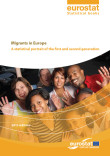Migrants in Europe. A Statistical portrait of the first and second generation.
This Eurostat-publication provides a wide range of information on the demographic and socio-economic characteristics of migrants.

Download publication
This Eurostat-publication provides a wide range of information on the demographic and socio-economic characteristics of migrants. The following points illustrate some of the key findings of the report:
- The labour market participation of first-generation migrants compares unfavourably to that of the native-born and nationals. The difference between the two groups results mainly from a considerably lower labour market participation of migrant women, particularly those with at least one child.
- Consistently higher levels of unemployment hamper the integration of migrants into the labour market. Higher levels of unemployment are seen for both male and female migrants and for migrants of all levels of education, including those with the highest qualifications.
- The potential misuse of skills and qualifications of highly qualified migrants not finding jobs is amplified by the large number of highly qualified migrants working in jobs well below their educational qualification.
-
Migrants also have a lower level of income and particularly those from outside the EU have a significantly increased risk of poverty or social exclusion, even if they are in employment. This risk is greater in households with children.
More information on the Eurostat website